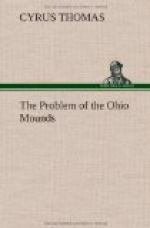Another writer says: “When the chief [of the Natchez] dies they demolish his cabin and then raise a new mound on which they build the cabin of him who is to replace him in this dignity.” [Footnote: La Petit, Hist. Coll. La., vol. 3, pp. 141, 142, note. Also Lettres edifiantes et curioses, vol. 1, pp. 260, 261. See Du Pratz. Histoire Louisiane, 1738, vol. 3, p. 16.]
According to Bartram, in the Cherokee town of Stico the council-house was on a mound, as also at Cowe. [Footnote: Bartram’s Travels, pp. 345, 367.]
The same writer says [Footnote: Ibid., p. 516.] the Choctaws raised mounds over their dead in case of communal burials.
It is apparent from Jefferson’s language [Footnote: Notes on Virginia. 4th Am ed., 1801, pp. 142-147.] that the burial mounds of Virginia were of Indian origin.
These references, which might be indefinitely multiplied, are sufficient to bear out the assertion that history testifies that the southern tribes were accustomed to build mounds.
It is a matter of surprise that so little is to be found regarding the mounds in the older records of the Northern States. There is but one statement in the Jesuit Relations and no mention in the writings of the Recollects, so far has been found, and yet one of the missionaries must have passed a good portion of the winter of 1700 in the very midst of the Cahokia group. Colden notes that “a round hill was sometimes raised over the grave in which a corpse had been deposited.” [Footnote: Hist. Five Nations, introd., vol. 1, London, 1755, p. 16.] Carver noticed ancient earthworks on the Mississippi near Lake Pepin, but knew nothing of their origin. [Footnote: Travels, ed. 1796, Phila., p. 36; ed. 1779, London, p. 57.] Heckewelder observed some of these works near Detroit, which he was informed had been built by the Indians. An account of them was published in a Philadelphia periodical in 1780 or 1790. This description was afterwards given briefly in his “History of the Manners and Customs of the Indian Nations.”
These older records mention facts which afford a reasonable explanation of some of the ancient monuments found in the northern section of the country; as for example the communal or tribal burials, where the bones and remains of all the dead of a village, region, or tribe, who had died since the last general burial (usually a period of eight to ten years) were collected and deposited in one common grave. This method, which was followed by some southern tribes, has been described by Bartram, [Footnote: Travels (1791), p.516.] Dumont, [Footnote: Memoires Hist. La., vol. 1, p. 246.] Romans, [Footnote: Nat. and Civil Hist. Fla., pp. 88-90.] and others, but most fully by Jean deo Brebeuf. [Footnote: In his account “Des ceremonies qu’ils [les Hurons] gardent en leur sepulture et de leur deuil,” and “De la Feste solemnelle des morts.”—Jesuit Relations for 1636, pp. 129-139. See translation in Thomas’s “Burial Mounds of the Northern Section of the United States,” Fifth Annual Rept. Bur. Ethnol., p. 110. See also Lafitau, “Moeurs des Sauvages,” vol. 2, pp. 447-455.]




